TLIF0002 Administering Chain of Responsibility Policies - RMIT
VerifiedAdded on 2023/06/03
|11
|3436
|419
Homework Assignment
AI Summary
This document provides a detailed solution to an exercise pack related to TLIF0002 Administer Chain of Responsibility Policies and Procedures, likely part of a Diploma of Logistics program at RMIT TAFE School. The solution covers various aspects of Chain of Responsibility (CoR), including risk management, relevant legislation (HVNL), and workplace policies. It addresses key areas such as defining CoR, identifying parties involved in the supply chain, summarizing HVNL acts, outlining duties and obligations of different parties, researching potential penalties for breaches, and describing workplace methods for managing speed, fatigue, vehicle dimensions, and loading procedures. The solution also includes examples of communication activities, monitoring practices, and actions to be taken in case of non-compliance. This comprehensive solution aims to demonstrate an understanding of administering CoR policies and procedures within a logistics context.
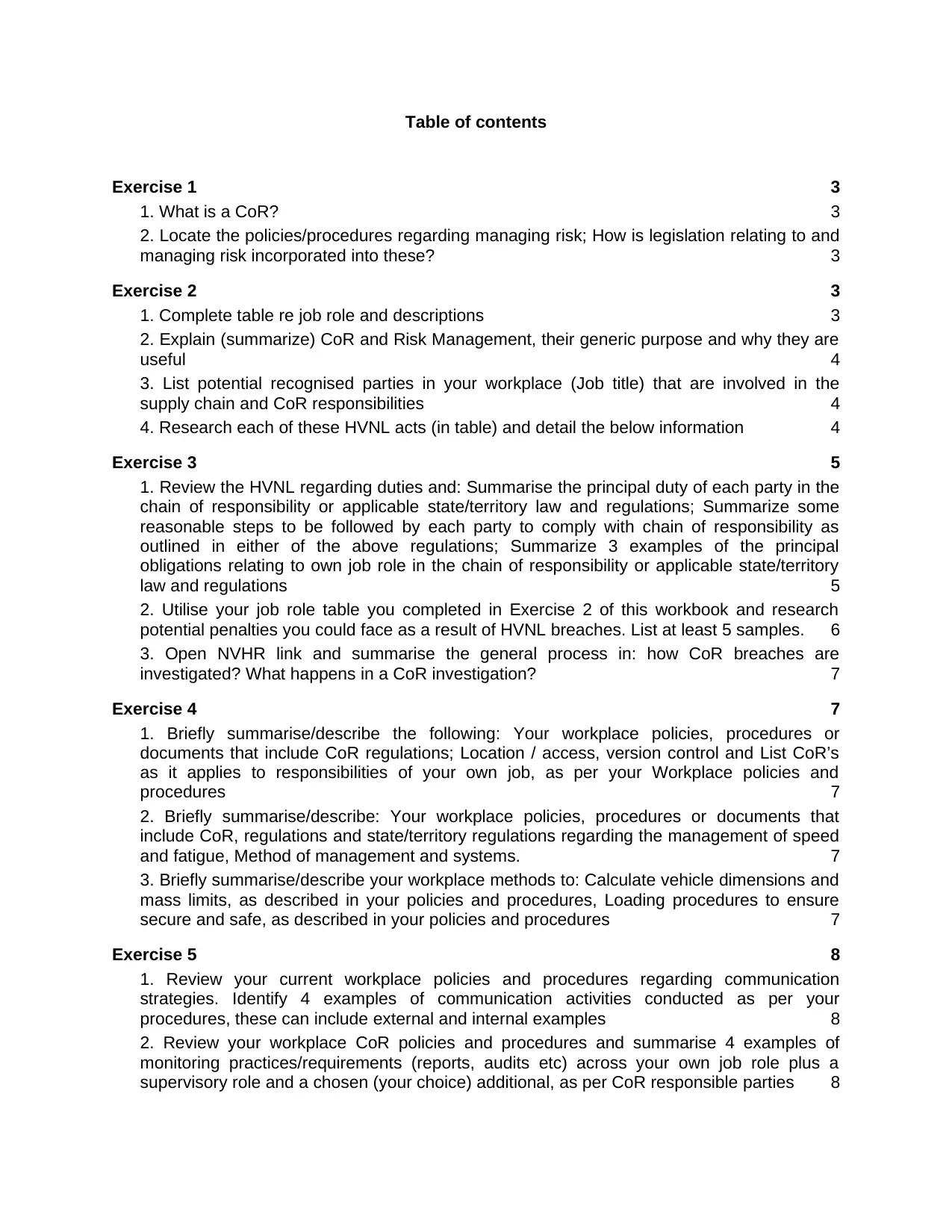
Table of contents
Exercise 1 3
1. What is a CoR? 3
2. Locate the policies/procedures regarding managing risk; How is legislation relating to and
managing risk incorporated into these? 3
Exercise 2 3
1. Complete table re job role and descriptions 3
2. Explain (summarize) CoR and Risk Management, their generic purpose and why they are
useful 4
3. List potential recognised parties in your workplace (Job title) that are involved in the
supply chain and CoR responsibilities 4
4. Research each of these HVNL acts (in table) and detail the below information 4
Exercise 3 5
1. Review the HVNL regarding duties and: Summarise the principal duty of each party in the
chain of responsibility or applicable state/territory law and regulations; Summarize some
reasonable steps to be followed by each party to comply with chain of responsibility as
outlined in either of the above regulations; Summarize 3 examples of the principal
obligations relating to own job role in the chain of responsibility or applicable state/territory
law and regulations 5
2. Utilise your job role table you completed in Exercise 2 of this workbook and research
potential penalties you could face as a result of HVNL breaches. List at least 5 samples. 6
3. Open NVHR link and summarise the general process in: how CoR breaches are
investigated? What happens in a CoR investigation? 7
Exercise 4 7
1. Briefly summarise/describe the following: Your workplace policies, procedures or
documents that include CoR regulations; Location / access, version control and List CoR’s
as it applies to responsibilities of your own job, as per your Workplace policies and
procedures 7
2. Briefly summarise/describe: Your workplace policies, procedures or documents that
include CoR, regulations and state/territory regulations regarding the management of speed
and fatigue, Method of management and systems. 7
3. Briefly summarise/describe your workplace methods to: Calculate vehicle dimensions and
mass limits, as described in your policies and procedures, Loading procedures to ensure
secure and safe, as described in your policies and procedures 7
Exercise 5 8
1. Review your current workplace policies and procedures regarding communication
strategies. Identify 4 examples of communication activities conducted as per your
procedures, these can include external and internal examples 8
2. Review your workplace CoR policies and procedures and summarise 4 examples of
monitoring practices/requirements (reports, audits etc) across your own job role plus a
supervisory role and a chosen (your choice) additional, as per CoR responsible parties 8
Exercise 1 3
1. What is a CoR? 3
2. Locate the policies/procedures regarding managing risk; How is legislation relating to and
managing risk incorporated into these? 3
Exercise 2 3
1. Complete table re job role and descriptions 3
2. Explain (summarize) CoR and Risk Management, their generic purpose and why they are
useful 4
3. List potential recognised parties in your workplace (Job title) that are involved in the
supply chain and CoR responsibilities 4
4. Research each of these HVNL acts (in table) and detail the below information 4
Exercise 3 5
1. Review the HVNL regarding duties and: Summarise the principal duty of each party in the
chain of responsibility or applicable state/territory law and regulations; Summarize some
reasonable steps to be followed by each party to comply with chain of responsibility as
outlined in either of the above regulations; Summarize 3 examples of the principal
obligations relating to own job role in the chain of responsibility or applicable state/territory
law and regulations 5
2. Utilise your job role table you completed in Exercise 2 of this workbook and research
potential penalties you could face as a result of HVNL breaches. List at least 5 samples. 6
3. Open NVHR link and summarise the general process in: how CoR breaches are
investigated? What happens in a CoR investigation? 7
Exercise 4 7
1. Briefly summarise/describe the following: Your workplace policies, procedures or
documents that include CoR regulations; Location / access, version control and List CoR’s
as it applies to responsibilities of your own job, as per your Workplace policies and
procedures 7
2. Briefly summarise/describe: Your workplace policies, procedures or documents that
include CoR, regulations and state/territory regulations regarding the management of speed
and fatigue, Method of management and systems. 7
3. Briefly summarise/describe your workplace methods to: Calculate vehicle dimensions and
mass limits, as described in your policies and procedures, Loading procedures to ensure
secure and safe, as described in your policies and procedures 7
Exercise 5 8
1. Review your current workplace policies and procedures regarding communication
strategies. Identify 4 examples of communication activities conducted as per your
procedures, these can include external and internal examples 8
2. Review your workplace CoR policies and procedures and summarise 4 examples of
monitoring practices/requirements (reports, audits etc) across your own job role plus a
supervisory role and a chosen (your choice) additional, as per CoR responsible parties 8
Paraphrase This Document
Need a fresh take? Get an instant paraphrase of this document with our AI Paraphraser
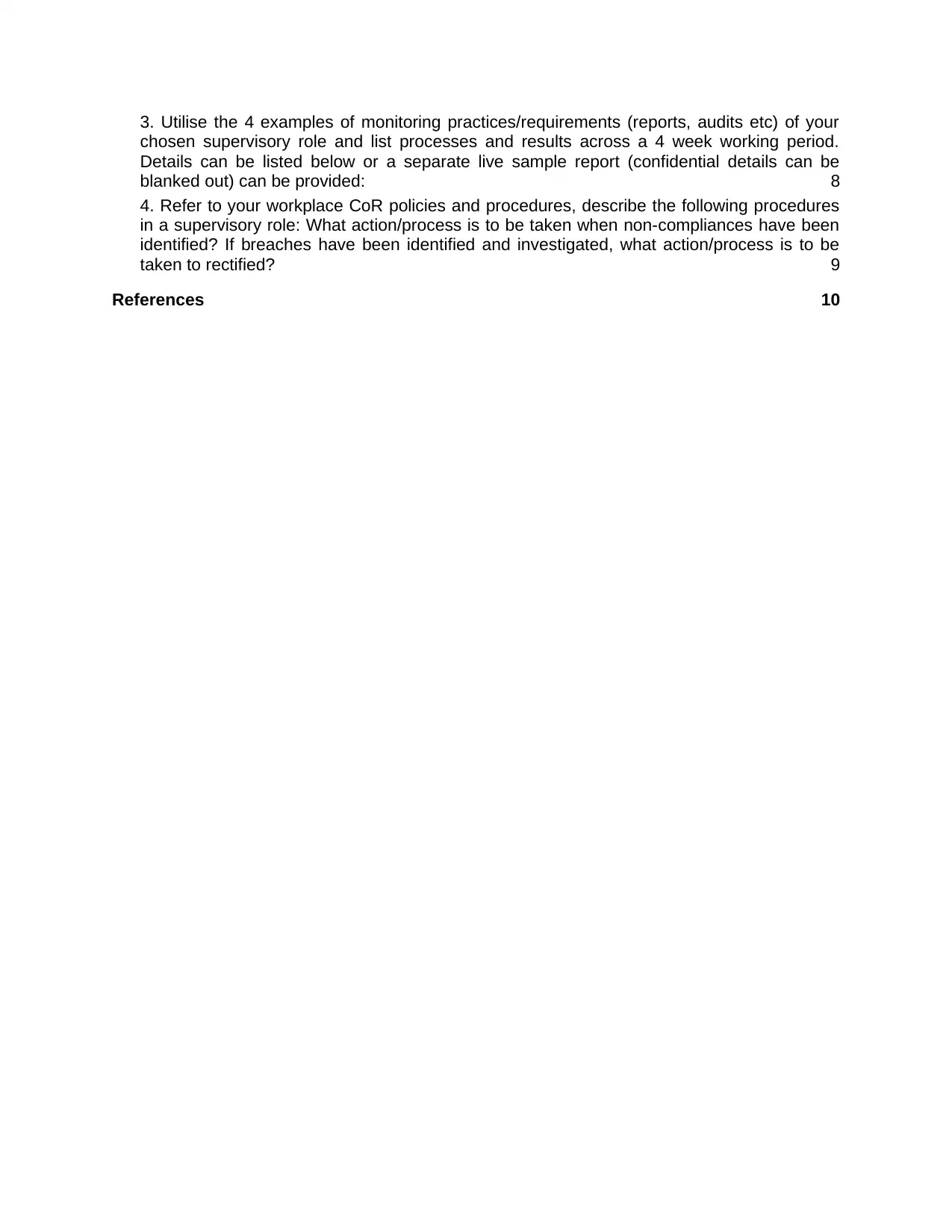
3. Utilise the 4 examples of monitoring practices/requirements (reports, audits etc) of your
chosen supervisory role and list processes and results across a 4 week working period.
Details can be listed below or a separate live sample report (confidential details can be
blanked out) can be provided: 8
4. Refer to your workplace CoR policies and procedures, describe the following procedures
in a supervisory role: What action/process is to be taken when non-compliances have been
identified? If breaches have been identified and investigated, what action/process is to be
taken to rectified? 9
References 10
chosen supervisory role and list processes and results across a 4 week working period.
Details can be listed below or a separate live sample report (confidential details can be
blanked out) can be provided: 8
4. Refer to your workplace CoR policies and procedures, describe the following procedures
in a supervisory role: What action/process is to be taken when non-compliances have been
identified? If breaches have been identified and investigated, what action/process is to be
taken to rectified? 9
References 10
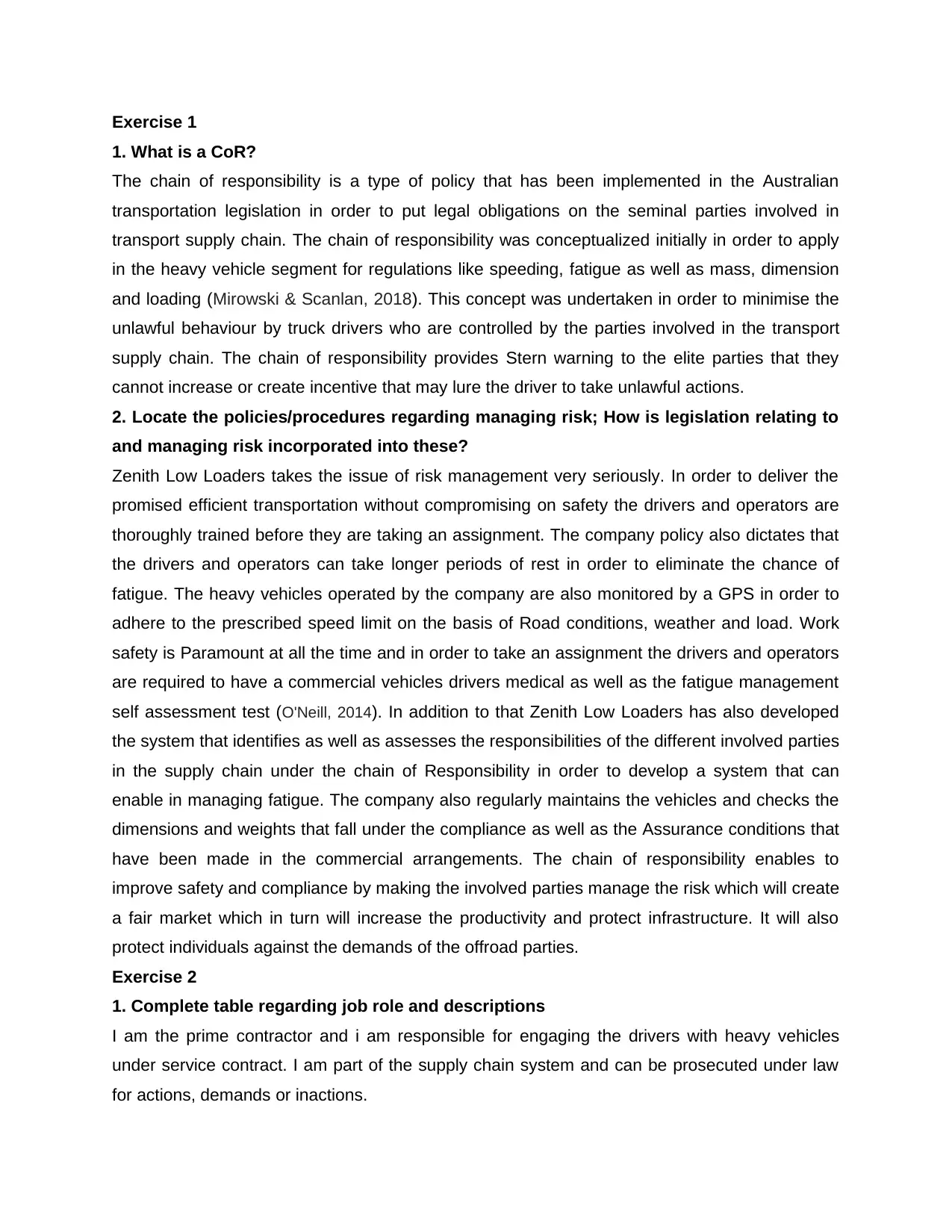
Exercise 1
1. What is a CoR?
The chain of responsibility is a type of policy that has been implemented in the Australian
transportation legislation in order to put legal obligations on the seminal parties involved in
transport supply chain. The chain of responsibility was conceptualized initially in order to apply
in the heavy vehicle segment for regulations like speeding, fatigue as well as mass, dimension
and loading (Mirowski & Scanlan, 2018). This concept was undertaken in order to minimise the
unlawful behaviour by truck drivers who are controlled by the parties involved in the transport
supply chain. The chain of responsibility provides Stern warning to the elite parties that they
cannot increase or create incentive that may lure the driver to take unlawful actions.
2. Locate the policies/procedures regarding managing risk; How is legislation relating to
and managing risk incorporated into these?
Zenith Low Loaders takes the issue of risk management very seriously. In order to deliver the
promised efficient transportation without compromising on safety the drivers and operators are
thoroughly trained before they are taking an assignment. The company policy also dictates that
the drivers and operators can take longer periods of rest in order to eliminate the chance of
fatigue. The heavy vehicles operated by the company are also monitored by a GPS in order to
adhere to the prescribed speed limit on the basis of Road conditions, weather and load. Work
safety is Paramount at all the time and in order to take an assignment the drivers and operators
are required to have a commercial vehicles drivers medical as well as the fatigue management
self assessment test (O'Neill, 2014). In addition to that Zenith Low Loaders has also developed
the system that identifies as well as assesses the responsibilities of the different involved parties
in the supply chain under the chain of Responsibility in order to develop a system that can
enable in managing fatigue. The company also regularly maintains the vehicles and checks the
dimensions and weights that fall under the compliance as well as the Assurance conditions that
have been made in the commercial arrangements. The chain of responsibility enables to
improve safety and compliance by making the involved parties manage the risk which will create
a fair market which in turn will increase the productivity and protect infrastructure. It will also
protect individuals against the demands of the offroad parties.
Exercise 2
1. Complete table regarding job role and descriptions
I am the prime contractor and i am responsible for engaging the drivers with heavy vehicles
under service contract. I am part of the supply chain system and can be prosecuted under law
for actions, demands or inactions.
1. What is a CoR?
The chain of responsibility is a type of policy that has been implemented in the Australian
transportation legislation in order to put legal obligations on the seminal parties involved in
transport supply chain. The chain of responsibility was conceptualized initially in order to apply
in the heavy vehicle segment for regulations like speeding, fatigue as well as mass, dimension
and loading (Mirowski & Scanlan, 2018). This concept was undertaken in order to minimise the
unlawful behaviour by truck drivers who are controlled by the parties involved in the transport
supply chain. The chain of responsibility provides Stern warning to the elite parties that they
cannot increase or create incentive that may lure the driver to take unlawful actions.
2. Locate the policies/procedures regarding managing risk; How is legislation relating to
and managing risk incorporated into these?
Zenith Low Loaders takes the issue of risk management very seriously. In order to deliver the
promised efficient transportation without compromising on safety the drivers and operators are
thoroughly trained before they are taking an assignment. The company policy also dictates that
the drivers and operators can take longer periods of rest in order to eliminate the chance of
fatigue. The heavy vehicles operated by the company are also monitored by a GPS in order to
adhere to the prescribed speed limit on the basis of Road conditions, weather and load. Work
safety is Paramount at all the time and in order to take an assignment the drivers and operators
are required to have a commercial vehicles drivers medical as well as the fatigue management
self assessment test (O'Neill, 2014). In addition to that Zenith Low Loaders has also developed
the system that identifies as well as assesses the responsibilities of the different involved parties
in the supply chain under the chain of Responsibility in order to develop a system that can
enable in managing fatigue. The company also regularly maintains the vehicles and checks the
dimensions and weights that fall under the compliance as well as the Assurance conditions that
have been made in the commercial arrangements. The chain of responsibility enables to
improve safety and compliance by making the involved parties manage the risk which will create
a fair market which in turn will increase the productivity and protect infrastructure. It will also
protect individuals against the demands of the offroad parties.
Exercise 2
1. Complete table regarding job role and descriptions
I am the prime contractor and i am responsible for engaging the drivers with heavy vehicles
under service contract. I am part of the supply chain system and can be prosecuted under law
for actions, demands or inactions.
⊘ This is a preview!⊘
Do you want full access?
Subscribe today to unlock all pages.

Trusted by 1+ million students worldwide
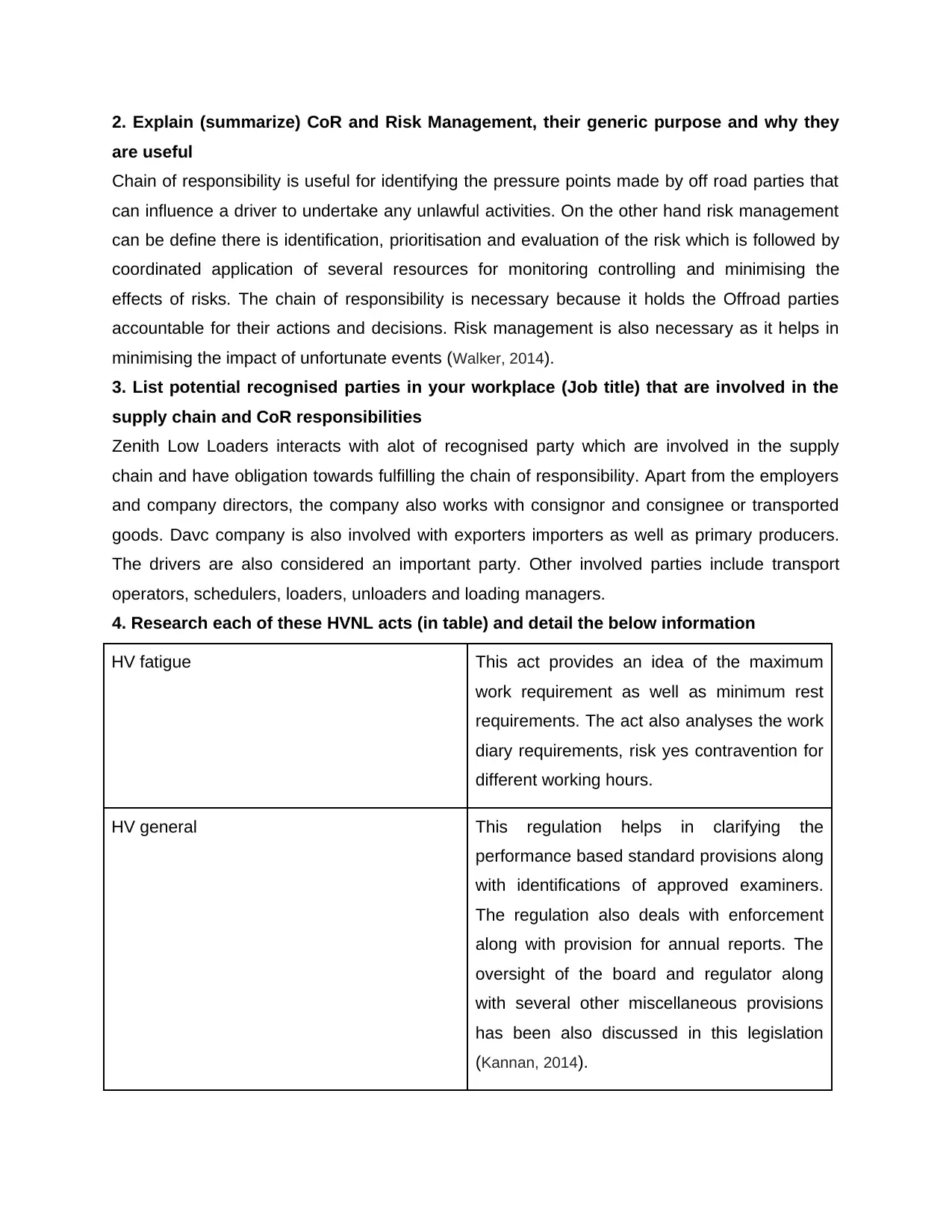
2. Explain (summarize) CoR and Risk Management, their generic purpose and why they
are useful
Chain of responsibility is useful for identifying the pressure points made by off road parties that
can influence a driver to undertake any unlawful activities. On the other hand risk management
can be define there is identification, prioritisation and evaluation of the risk which is followed by
coordinated application of several resources for monitoring controlling and minimising the
effects of risks. The chain of responsibility is necessary because it holds the Offroad parties
accountable for their actions and decisions. Risk management is also necessary as it helps in
minimising the impact of unfortunate events (Walker, 2014).
3. List potential recognised parties in your workplace (Job title) that are involved in the
supply chain and CoR responsibilities
Zenith Low Loaders interacts with alot of recognised party which are involved in the supply
chain and have obligation towards fulfilling the chain of responsibility. Apart from the employers
and company directors, the company also works with consignor and consignee or transported
goods. Davc company is also involved with exporters importers as well as primary producers.
The drivers are also considered an important party. Other involved parties include transport
operators, schedulers, loaders, unloaders and loading managers.
4. Research each of these HVNL acts (in table) and detail the below information
HV fatigue This act provides an idea of the maximum
work requirement as well as minimum rest
requirements. The act also analyses the work
diary requirements, risk yes contravention for
different working hours.
HV general This regulation helps in clarifying the
performance based standard provisions along
with identifications of approved examiners.
The regulation also deals with enforcement
along with provision for annual reports. The
oversight of the board and regulator along
with several other miscellaneous provisions
has been also discussed in this legislation
(Kannan, 2014).
are useful
Chain of responsibility is useful for identifying the pressure points made by off road parties that
can influence a driver to undertake any unlawful activities. On the other hand risk management
can be define there is identification, prioritisation and evaluation of the risk which is followed by
coordinated application of several resources for monitoring controlling and minimising the
effects of risks. The chain of responsibility is necessary because it holds the Offroad parties
accountable for their actions and decisions. Risk management is also necessary as it helps in
minimising the impact of unfortunate events (Walker, 2014).
3. List potential recognised parties in your workplace (Job title) that are involved in the
supply chain and CoR responsibilities
Zenith Low Loaders interacts with alot of recognised party which are involved in the supply
chain and have obligation towards fulfilling the chain of responsibility. Apart from the employers
and company directors, the company also works with consignor and consignee or transported
goods. Davc company is also involved with exporters importers as well as primary producers.
The drivers are also considered an important party. Other involved parties include transport
operators, schedulers, loaders, unloaders and loading managers.
4. Research each of these HVNL acts (in table) and detail the below information
HV fatigue This act provides an idea of the maximum
work requirement as well as minimum rest
requirements. The act also analyses the work
diary requirements, risk yes contravention for
different working hours.
HV general This regulation helps in clarifying the
performance based standard provisions along
with identifications of approved examiners.
The regulation also deals with enforcement
along with provision for annual reports. The
oversight of the board and regulator along
with several other miscellaneous provisions
has been also discussed in this legislation
(Kannan, 2014).
Paraphrase This Document
Need a fresh take? Get an instant paraphrase of this document with our AI Paraphraser
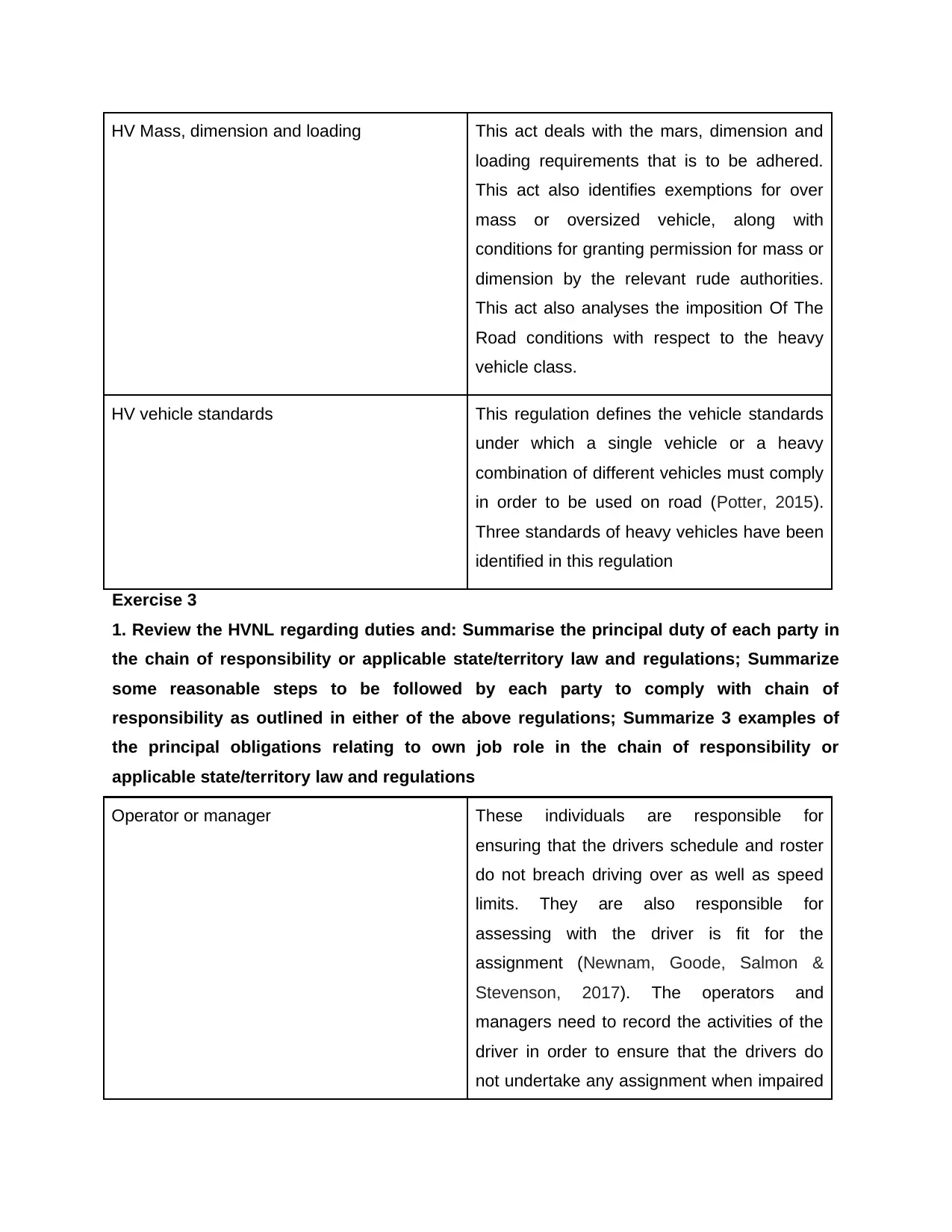
HV Mass, dimension and loading This act deals with the mars, dimension and
loading requirements that is to be adhered.
This act also identifies exemptions for over
mass or oversized vehicle, along with
conditions for granting permission for mass or
dimension by the relevant rude authorities.
This act also analyses the imposition Of The
Road conditions with respect to the heavy
vehicle class.
HV vehicle standards This regulation defines the vehicle standards
under which a single vehicle or a heavy
combination of different vehicles must comply
in order to be used on road (Potter, 2015).
Three standards of heavy vehicles have been
identified in this regulation
Exercise 3
1. Review the HVNL regarding duties and: Summarise the principal duty of each party in
the chain of responsibility or applicable state/territory law and regulations; Summarize
some reasonable steps to be followed by each party to comply with chain of
responsibility as outlined in either of the above regulations; Summarize 3 examples of
the principal obligations relating to own job role in the chain of responsibility or
applicable state/territory law and regulations
Operator or manager These individuals are responsible for
ensuring that the drivers schedule and roster
do not breach driving over as well as speed
limits. They are also responsible for
assessing with the driver is fit for the
assignment (Newnam, Goode, Salmon &
Stevenson, 2017). The operators and
managers need to record the activities of the
driver in order to ensure that the drivers do
not undertake any assignment when impaired
loading requirements that is to be adhered.
This act also identifies exemptions for over
mass or oversized vehicle, along with
conditions for granting permission for mass or
dimension by the relevant rude authorities.
This act also analyses the imposition Of The
Road conditions with respect to the heavy
vehicle class.
HV vehicle standards This regulation defines the vehicle standards
under which a single vehicle or a heavy
combination of different vehicles must comply
in order to be used on road (Potter, 2015).
Three standards of heavy vehicles have been
identified in this regulation
Exercise 3
1. Review the HVNL regarding duties and: Summarise the principal duty of each party in
the chain of responsibility or applicable state/territory law and regulations; Summarize
some reasonable steps to be followed by each party to comply with chain of
responsibility as outlined in either of the above regulations; Summarize 3 examples of
the principal obligations relating to own job role in the chain of responsibility or
applicable state/territory law and regulations
Operator or manager These individuals are responsible for
ensuring that the drivers schedule and roster
do not breach driving over as well as speed
limits. They are also responsible for
assessing with the driver is fit for the
assignment (Newnam, Goode, Salmon &
Stevenson, 2017). The operators and
managers need to record the activities of the
driver in order to ensure that the drivers do
not undertake any assignment when impaired
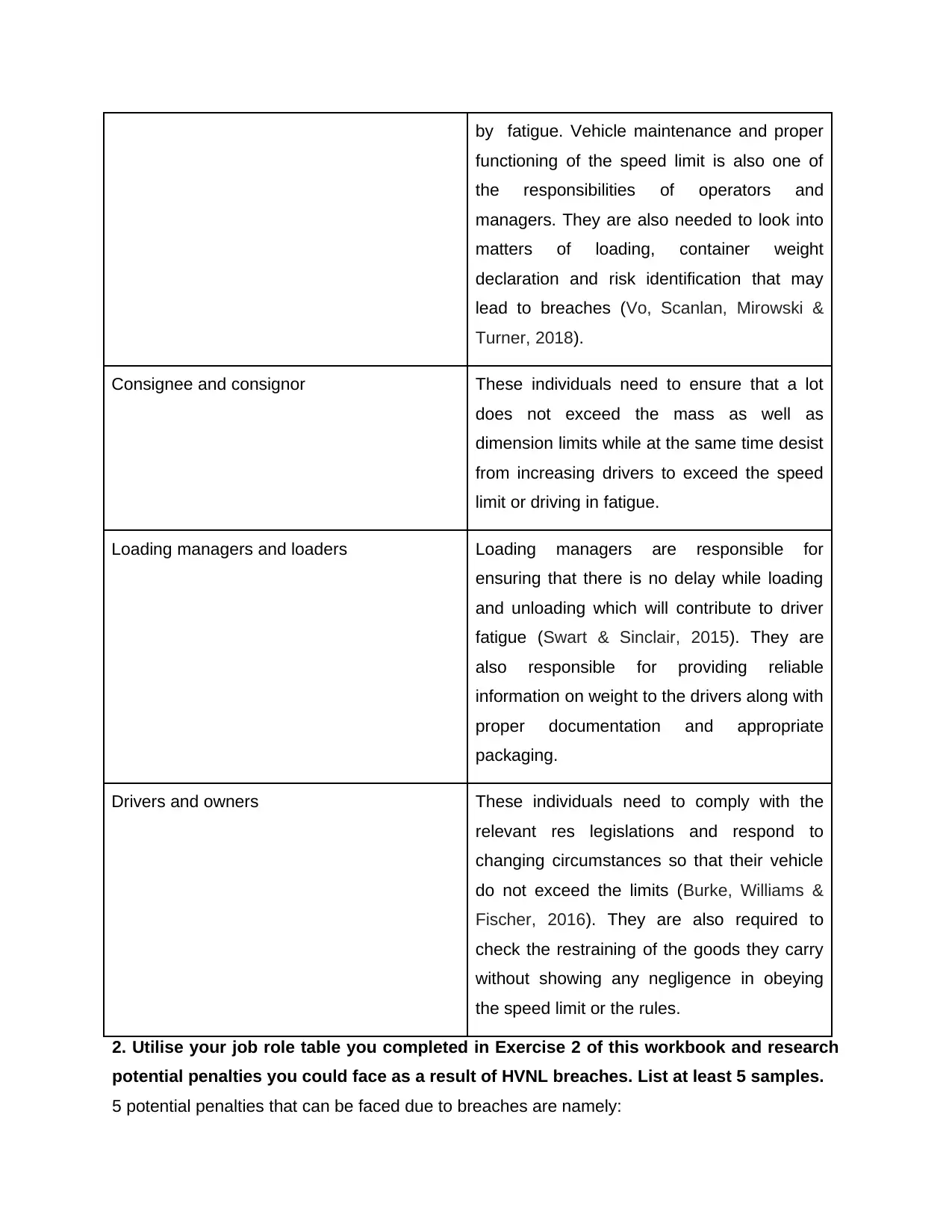
by fatigue. Vehicle maintenance and proper
functioning of the speed limit is also one of
the responsibilities of operators and
managers. They are also needed to look into
matters of loading, container weight
declaration and risk identification that may
lead to breaches (Vo, Scanlan, Mirowski &
Turner, 2018).
Consignee and consignor These individuals need to ensure that a lot
does not exceed the mass as well as
dimension limits while at the same time desist
from increasing drivers to exceed the speed
limit or driving in fatigue.
Loading managers and loaders Loading managers are responsible for
ensuring that there is no delay while loading
and unloading which will contribute to driver
fatigue (Swart & Sinclair, 2015). They are
also responsible for providing reliable
information on weight to the drivers along with
proper documentation and appropriate
packaging.
Drivers and owners These individuals need to comply with the
relevant res legislations and respond to
changing circumstances so that their vehicle
do not exceed the limits (Burke, Williams &
Fischer, 2016). They are also required to
check the restraining of the goods they carry
without showing any negligence in obeying
the speed limit or the rules.
2. Utilise your job role table you completed in Exercise 2 of this workbook and research
potential penalties you could face as a result of HVNL breaches. List at least 5 samples.
5 potential penalties that can be faced due to breaches are namely:
functioning of the speed limit is also one of
the responsibilities of operators and
managers. They are also needed to look into
matters of loading, container weight
declaration and risk identification that may
lead to breaches (Vo, Scanlan, Mirowski &
Turner, 2018).
Consignee and consignor These individuals need to ensure that a lot
does not exceed the mass as well as
dimension limits while at the same time desist
from increasing drivers to exceed the speed
limit or driving in fatigue.
Loading managers and loaders Loading managers are responsible for
ensuring that there is no delay while loading
and unloading which will contribute to driver
fatigue (Swart & Sinclair, 2015). They are
also responsible for providing reliable
information on weight to the drivers along with
proper documentation and appropriate
packaging.
Drivers and owners These individuals need to comply with the
relevant res legislations and respond to
changing circumstances so that their vehicle
do not exceed the limits (Burke, Williams &
Fischer, 2016). They are also required to
check the restraining of the goods they carry
without showing any negligence in obeying
the speed limit or the rules.
2. Utilise your job role table you completed in Exercise 2 of this workbook and research
potential penalties you could face as a result of HVNL breaches. List at least 5 samples.
5 potential penalties that can be faced due to breaches are namely:
⊘ This is a preview!⊘
Do you want full access?
Subscribe today to unlock all pages.

Trusted by 1+ million students worldwide
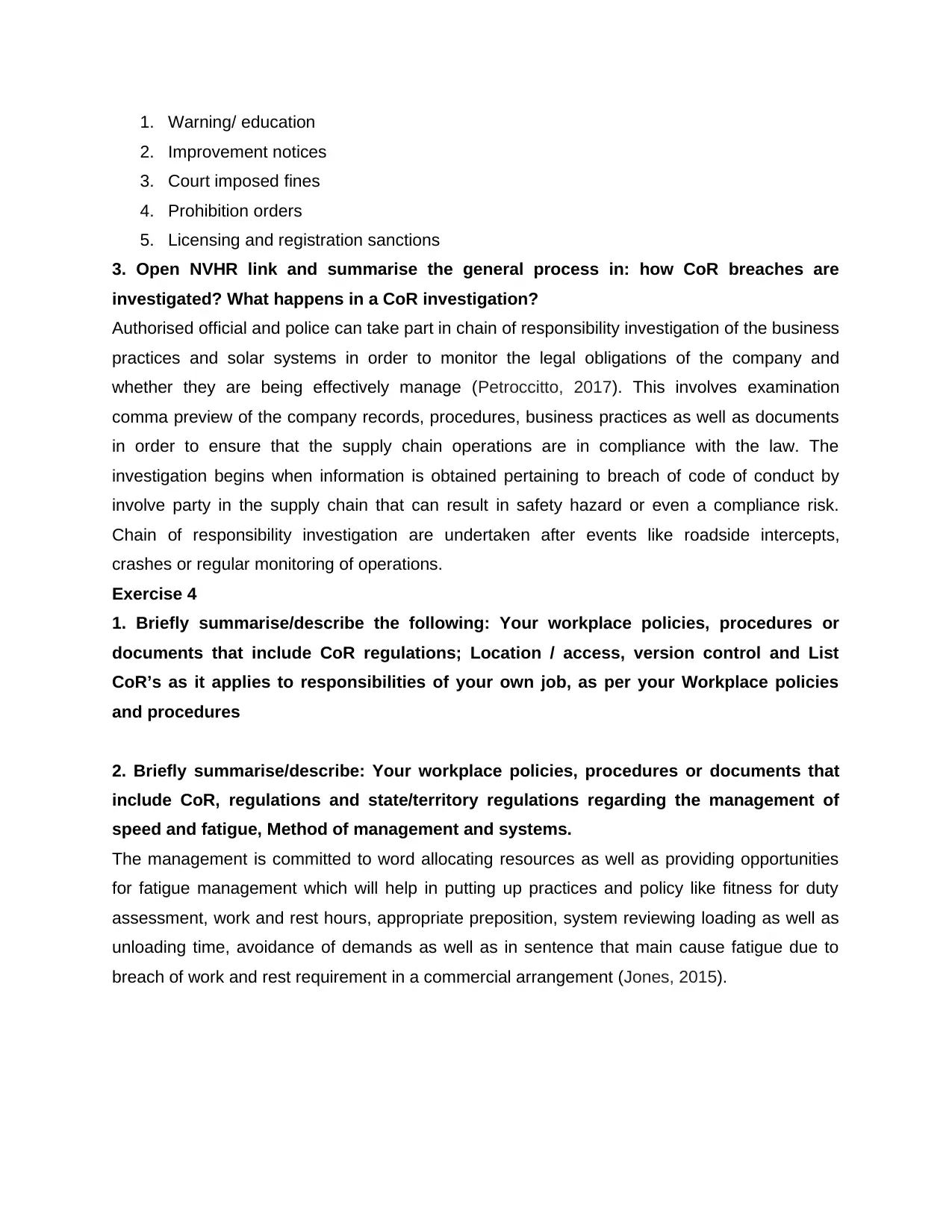
1. Warning/ education
2. Improvement notices
3. Court imposed fines
4. Prohibition orders
5. Licensing and registration sanctions
3. Open NVHR link and summarise the general process in: how CoR breaches are
investigated? What happens in a CoR investigation?
Authorised official and police can take part in chain of responsibility investigation of the business
practices and solar systems in order to monitor the legal obligations of the company and
whether they are being effectively manage (Petroccitto, 2017). This involves examination
comma preview of the company records, procedures, business practices as well as documents
in order to ensure that the supply chain operations are in compliance with the law. The
investigation begins when information is obtained pertaining to breach of code of conduct by
involve party in the supply chain that can result in safety hazard or even a compliance risk.
Chain of responsibility investigation are undertaken after events like roadside intercepts,
crashes or regular monitoring of operations.
Exercise 4
1. Briefly summarise/describe the following: Your workplace policies, procedures or
documents that include CoR regulations; Location / access, version control and List
CoR’s as it applies to responsibilities of your own job, as per your Workplace policies
and procedures
2. Briefly summarise/describe: Your workplace policies, procedures or documents that
include CoR, regulations and state/territory regulations regarding the management of
speed and fatigue, Method of management and systems.
The management is committed to word allocating resources as well as providing opportunities
for fatigue management which will help in putting up practices and policy like fitness for duty
assessment, work and rest hours, appropriate preposition, system reviewing loading as well as
unloading time, avoidance of demands as well as in sentence that main cause fatigue due to
breach of work and rest requirement in a commercial arrangement (Jones, 2015).
2. Improvement notices
3. Court imposed fines
4. Prohibition orders
5. Licensing and registration sanctions
3. Open NVHR link and summarise the general process in: how CoR breaches are
investigated? What happens in a CoR investigation?
Authorised official and police can take part in chain of responsibility investigation of the business
practices and solar systems in order to monitor the legal obligations of the company and
whether they are being effectively manage (Petroccitto, 2017). This involves examination
comma preview of the company records, procedures, business practices as well as documents
in order to ensure that the supply chain operations are in compliance with the law. The
investigation begins when information is obtained pertaining to breach of code of conduct by
involve party in the supply chain that can result in safety hazard or even a compliance risk.
Chain of responsibility investigation are undertaken after events like roadside intercepts,
crashes or regular monitoring of operations.
Exercise 4
1. Briefly summarise/describe the following: Your workplace policies, procedures or
documents that include CoR regulations; Location / access, version control and List
CoR’s as it applies to responsibilities of your own job, as per your Workplace policies
and procedures
2. Briefly summarise/describe: Your workplace policies, procedures or documents that
include CoR, regulations and state/territory regulations regarding the management of
speed and fatigue, Method of management and systems.
The management is committed to word allocating resources as well as providing opportunities
for fatigue management which will help in putting up practices and policy like fitness for duty
assessment, work and rest hours, appropriate preposition, system reviewing loading as well as
unloading time, avoidance of demands as well as in sentence that main cause fatigue due to
breach of work and rest requirement in a commercial arrangement (Jones, 2015).
Paraphrase This Document
Need a fresh take? Get an instant paraphrase of this document with our AI Paraphraser
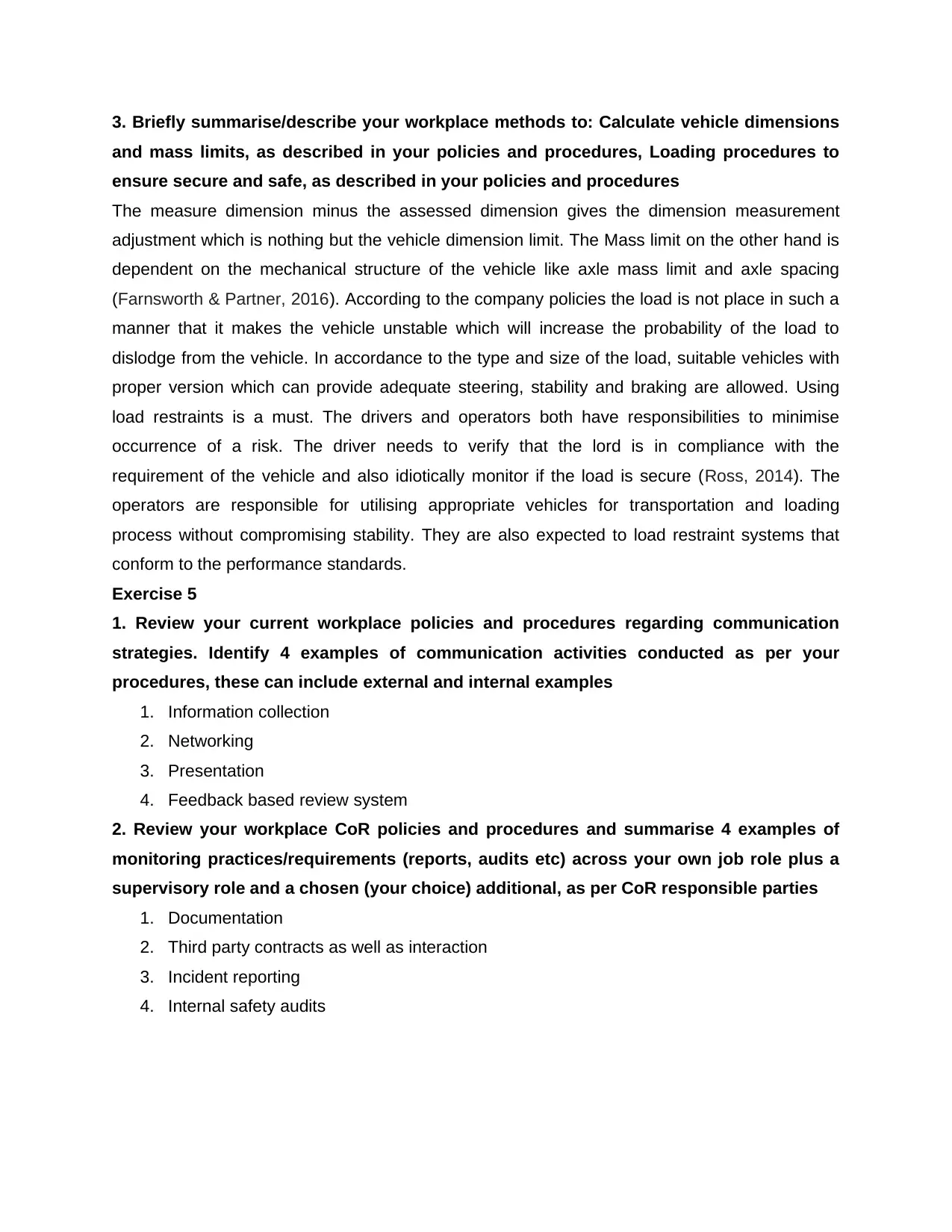
3. Briefly summarise/describe your workplace methods to: Calculate vehicle dimensions
and mass limits, as described in your policies and procedures, Loading procedures to
ensure secure and safe, as described in your policies and procedures
The measure dimension minus the assessed dimension gives the dimension measurement
adjustment which is nothing but the vehicle dimension limit. The Mass limit on the other hand is
dependent on the mechanical structure of the vehicle like axle mass limit and axle spacing
(Farnsworth & Partner, 2016). According to the company policies the load is not place in such a
manner that it makes the vehicle unstable which will increase the probability of the load to
dislodge from the vehicle. In accordance to the type and size of the load, suitable vehicles with
proper version which can provide adequate steering, stability and braking are allowed. Using
load restraints is a must. The drivers and operators both have responsibilities to minimise
occurrence of a risk. The driver needs to verify that the lord is in compliance with the
requirement of the vehicle and also idiotically monitor if the load is secure (Ross, 2014). The
operators are responsible for utilising appropriate vehicles for transportation and loading
process without compromising stability. They are also expected to load restraint systems that
conform to the performance standards.
Exercise 5
1. Review your current workplace policies and procedures regarding communication
strategies. Identify 4 examples of communication activities conducted as per your
procedures, these can include external and internal examples
1. Information collection
2. Networking
3. Presentation
4. Feedback based review system
2. Review your workplace CoR policies and procedures and summarise 4 examples of
monitoring practices/requirements (reports, audits etc) across your own job role plus a
supervisory role and a chosen (your choice) additional, as per CoR responsible parties
1. Documentation
2. Third party contracts as well as interaction
3. Incident reporting
4. Internal safety audits
and mass limits, as described in your policies and procedures, Loading procedures to
ensure secure and safe, as described in your policies and procedures
The measure dimension minus the assessed dimension gives the dimension measurement
adjustment which is nothing but the vehicle dimension limit. The Mass limit on the other hand is
dependent on the mechanical structure of the vehicle like axle mass limit and axle spacing
(Farnsworth & Partner, 2016). According to the company policies the load is not place in such a
manner that it makes the vehicle unstable which will increase the probability of the load to
dislodge from the vehicle. In accordance to the type and size of the load, suitable vehicles with
proper version which can provide adequate steering, stability and braking are allowed. Using
load restraints is a must. The drivers and operators both have responsibilities to minimise
occurrence of a risk. The driver needs to verify that the lord is in compliance with the
requirement of the vehicle and also idiotically monitor if the load is secure (Ross, 2014). The
operators are responsible for utilising appropriate vehicles for transportation and loading
process without compromising stability. They are also expected to load restraint systems that
conform to the performance standards.
Exercise 5
1. Review your current workplace policies and procedures regarding communication
strategies. Identify 4 examples of communication activities conducted as per your
procedures, these can include external and internal examples
1. Information collection
2. Networking
3. Presentation
4. Feedback based review system
2. Review your workplace CoR policies and procedures and summarise 4 examples of
monitoring practices/requirements (reports, audits etc) across your own job role plus a
supervisory role and a chosen (your choice) additional, as per CoR responsible parties
1. Documentation
2. Third party contracts as well as interaction
3. Incident reporting
4. Internal safety audits
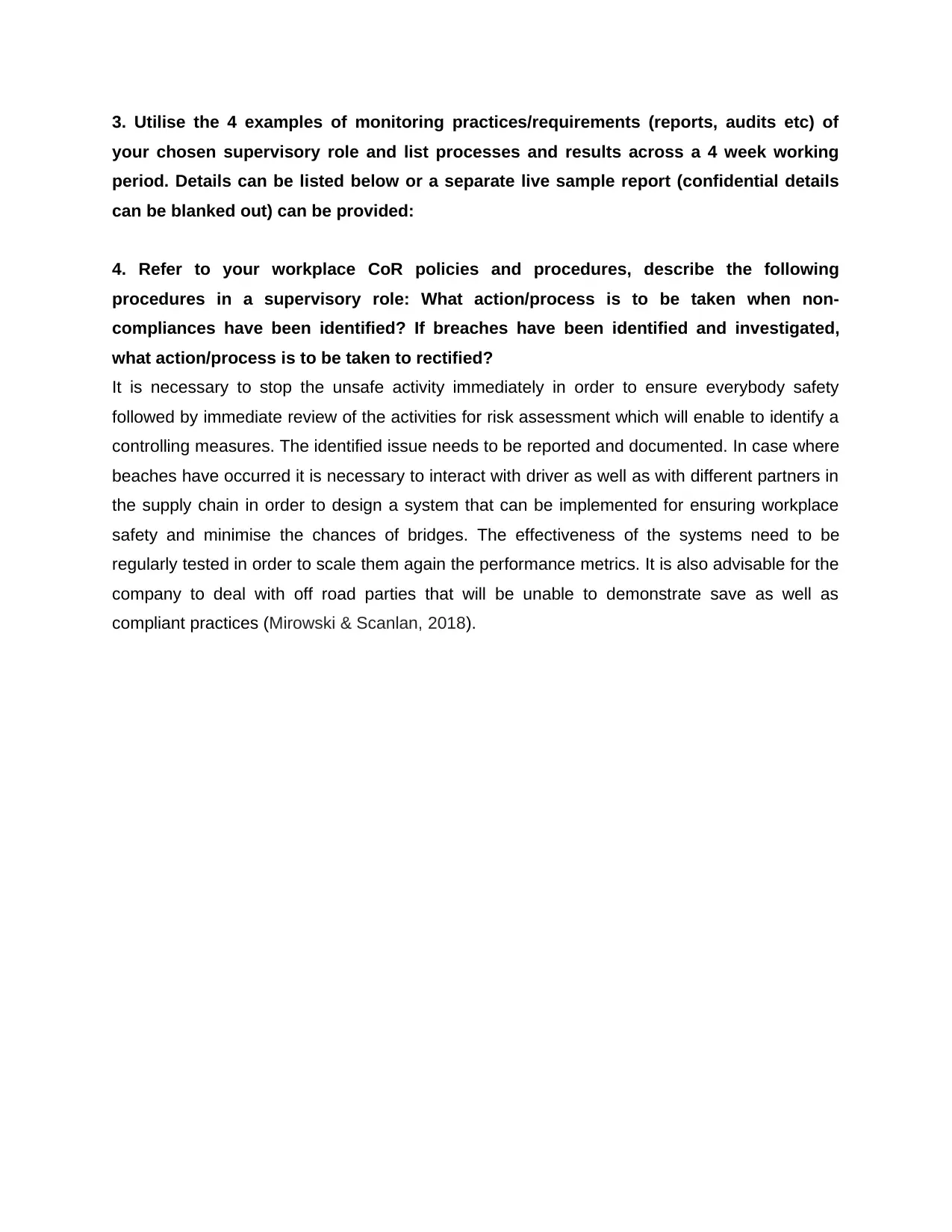
3. Utilise the 4 examples of monitoring practices/requirements (reports, audits etc) of
your chosen supervisory role and list processes and results across a 4 week working
period. Details can be listed below or a separate live sample report (confidential details
can be blanked out) can be provided:
4. Refer to your workplace CoR policies and procedures, describe the following
procedures in a supervisory role: What action/process is to be taken when non-
compliances have been identified? If breaches have been identified and investigated,
what action/process is to be taken to rectified?
It is necessary to stop the unsafe activity immediately in order to ensure everybody safety
followed by immediate review of the activities for risk assessment which will enable to identify a
controlling measures. The identified issue needs to be reported and documented. In case where
beaches have occurred it is necessary to interact with driver as well as with different partners in
the supply chain in order to design a system that can be implemented for ensuring workplace
safety and minimise the chances of bridges. The effectiveness of the systems need to be
regularly tested in order to scale them again the performance metrics. It is also advisable for the
company to deal with off road parties that will be unable to demonstrate save as well as
compliant practices (Mirowski & Scanlan, 2018).
your chosen supervisory role and list processes and results across a 4 week working
period. Details can be listed below or a separate live sample report (confidential details
can be blanked out) can be provided:
4. Refer to your workplace CoR policies and procedures, describe the following
procedures in a supervisory role: What action/process is to be taken when non-
compliances have been identified? If breaches have been identified and investigated,
what action/process is to be taken to rectified?
It is necessary to stop the unsafe activity immediately in order to ensure everybody safety
followed by immediate review of the activities for risk assessment which will enable to identify a
controlling measures. The identified issue needs to be reported and documented. In case where
beaches have occurred it is necessary to interact with driver as well as with different partners in
the supply chain in order to design a system that can be implemented for ensuring workplace
safety and minimise the chances of bridges. The effectiveness of the systems need to be
regularly tested in order to scale them again the performance metrics. It is also advisable for the
company to deal with off road parties that will be unable to demonstrate save as well as
compliant practices (Mirowski & Scanlan, 2018).
⊘ This is a preview!⊘
Do you want full access?
Subscribe today to unlock all pages.

Trusted by 1+ million students worldwide
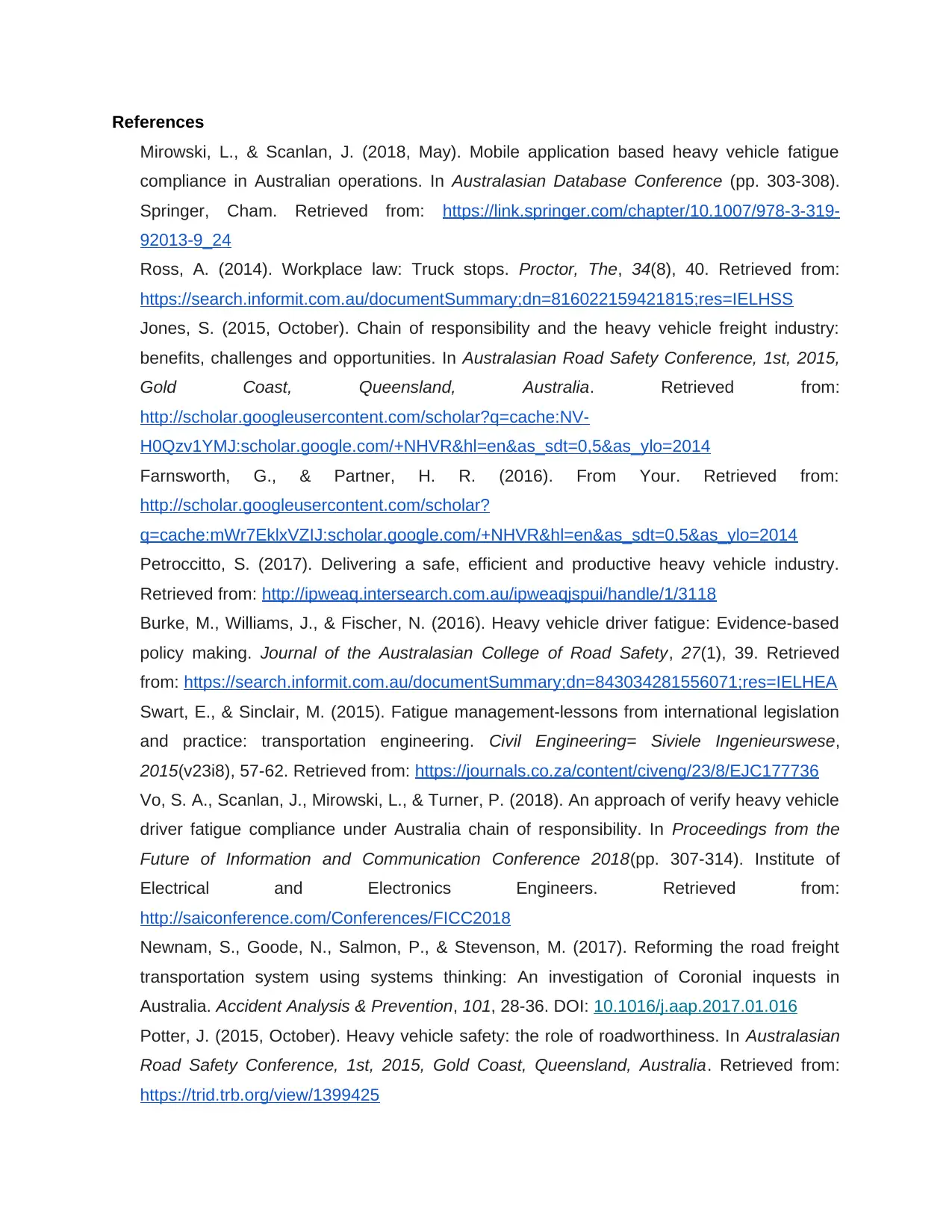
References
Mirowski, L., & Scanlan, J. (2018, May). Mobile application based heavy vehicle fatigue
compliance in Australian operations. In Australasian Database Conference (pp. 303-308).
Springer, Cham. Retrieved from: https://link.springer.com/chapter/10.1007/978-3-319-
92013-9_24
Ross, A. (2014). Workplace law: Truck stops. Proctor, The, 34(8), 40. Retrieved from:
https://search.informit.com.au/documentSummary;dn=816022159421815;res=IELHSS
Jones, S. (2015, October). Chain of responsibility and the heavy vehicle freight industry:
benefits, challenges and opportunities. In Australasian Road Safety Conference, 1st, 2015,
Gold Coast, Queensland, Australia. Retrieved from:
http://scholar.googleusercontent.com/scholar?q=cache:NV-
H0Qzv1YMJ:scholar.google.com/+NHVR&hl=en&as_sdt=0,5&as_ylo=2014
Farnsworth, G., & Partner, H. R. (2016). From Your. Retrieved from:
http://scholar.googleusercontent.com/scholar?
q=cache:mWr7EklxVZIJ:scholar.google.com/+NHVR&hl=en&as_sdt=0,5&as_ylo=2014
Petroccitto, S. (2017). Delivering a safe, efficient and productive heavy vehicle industry.
Retrieved from: http://ipweaq.intersearch.com.au/ipweaqjspui/handle/1/3118
Burke, M., Williams, J., & Fischer, N. (2016). Heavy vehicle driver fatigue: Evidence-based
policy making. Journal of the Australasian College of Road Safety, 27(1), 39. Retrieved
from: https://search.informit.com.au/documentSummary;dn=843034281556071;res=IELHEA
Swart, E., & Sinclair, M. (2015). Fatigue management-lessons from international legislation
and practice: transportation engineering. Civil Engineering= Siviele Ingenieurswese,
2015(v23i8), 57-62. Retrieved from: https://journals.co.za/content/civeng/23/8/EJC177736
Vo, S. A., Scanlan, J., Mirowski, L., & Turner, P. (2018). An approach of verify heavy vehicle
driver fatigue compliance under Australia chain of responsibility. In Proceedings from the
Future of Information and Communication Conference 2018(pp. 307-314). Institute of
Electrical and Electronics Engineers. Retrieved from:
http://saiconference.com/Conferences/FICC2018
Newnam, S., Goode, N., Salmon, P., & Stevenson, M. (2017). Reforming the road freight
transportation system using systems thinking: An investigation of Coronial inquests in
Australia. Accident Analysis & Prevention, 101, 28-36. DOI: 10.1016/j.aap.2017.01.016
Potter, J. (2015, October). Heavy vehicle safety: the role of roadworthiness. In Australasian
Road Safety Conference, 1st, 2015, Gold Coast, Queensland, Australia. Retrieved from:
https://trid.trb.org/view/1399425
Mirowski, L., & Scanlan, J. (2018, May). Mobile application based heavy vehicle fatigue
compliance in Australian operations. In Australasian Database Conference (pp. 303-308).
Springer, Cham. Retrieved from: https://link.springer.com/chapter/10.1007/978-3-319-
92013-9_24
Ross, A. (2014). Workplace law: Truck stops. Proctor, The, 34(8), 40. Retrieved from:
https://search.informit.com.au/documentSummary;dn=816022159421815;res=IELHSS
Jones, S. (2015, October). Chain of responsibility and the heavy vehicle freight industry:
benefits, challenges and opportunities. In Australasian Road Safety Conference, 1st, 2015,
Gold Coast, Queensland, Australia. Retrieved from:
http://scholar.googleusercontent.com/scholar?q=cache:NV-
H0Qzv1YMJ:scholar.google.com/+NHVR&hl=en&as_sdt=0,5&as_ylo=2014
Farnsworth, G., & Partner, H. R. (2016). From Your. Retrieved from:
http://scholar.googleusercontent.com/scholar?
q=cache:mWr7EklxVZIJ:scholar.google.com/+NHVR&hl=en&as_sdt=0,5&as_ylo=2014
Petroccitto, S. (2017). Delivering a safe, efficient and productive heavy vehicle industry.
Retrieved from: http://ipweaq.intersearch.com.au/ipweaqjspui/handle/1/3118
Burke, M., Williams, J., & Fischer, N. (2016). Heavy vehicle driver fatigue: Evidence-based
policy making. Journal of the Australasian College of Road Safety, 27(1), 39. Retrieved
from: https://search.informit.com.au/documentSummary;dn=843034281556071;res=IELHEA
Swart, E., & Sinclair, M. (2015). Fatigue management-lessons from international legislation
and practice: transportation engineering. Civil Engineering= Siviele Ingenieurswese,
2015(v23i8), 57-62. Retrieved from: https://journals.co.za/content/civeng/23/8/EJC177736
Vo, S. A., Scanlan, J., Mirowski, L., & Turner, P. (2018). An approach of verify heavy vehicle
driver fatigue compliance under Australia chain of responsibility. In Proceedings from the
Future of Information and Communication Conference 2018(pp. 307-314). Institute of
Electrical and Electronics Engineers. Retrieved from:
http://saiconference.com/Conferences/FICC2018
Newnam, S., Goode, N., Salmon, P., & Stevenson, M. (2017). Reforming the road freight
transportation system using systems thinking: An investigation of Coronial inquests in
Australia. Accident Analysis & Prevention, 101, 28-36. DOI: 10.1016/j.aap.2017.01.016
Potter, J. (2015, October). Heavy vehicle safety: the role of roadworthiness. In Australasian
Road Safety Conference, 1st, 2015, Gold Coast, Queensland, Australia. Retrieved from:
https://trid.trb.org/view/1399425
Paraphrase This Document
Need a fresh take? Get an instant paraphrase of this document with our AI Paraphraser
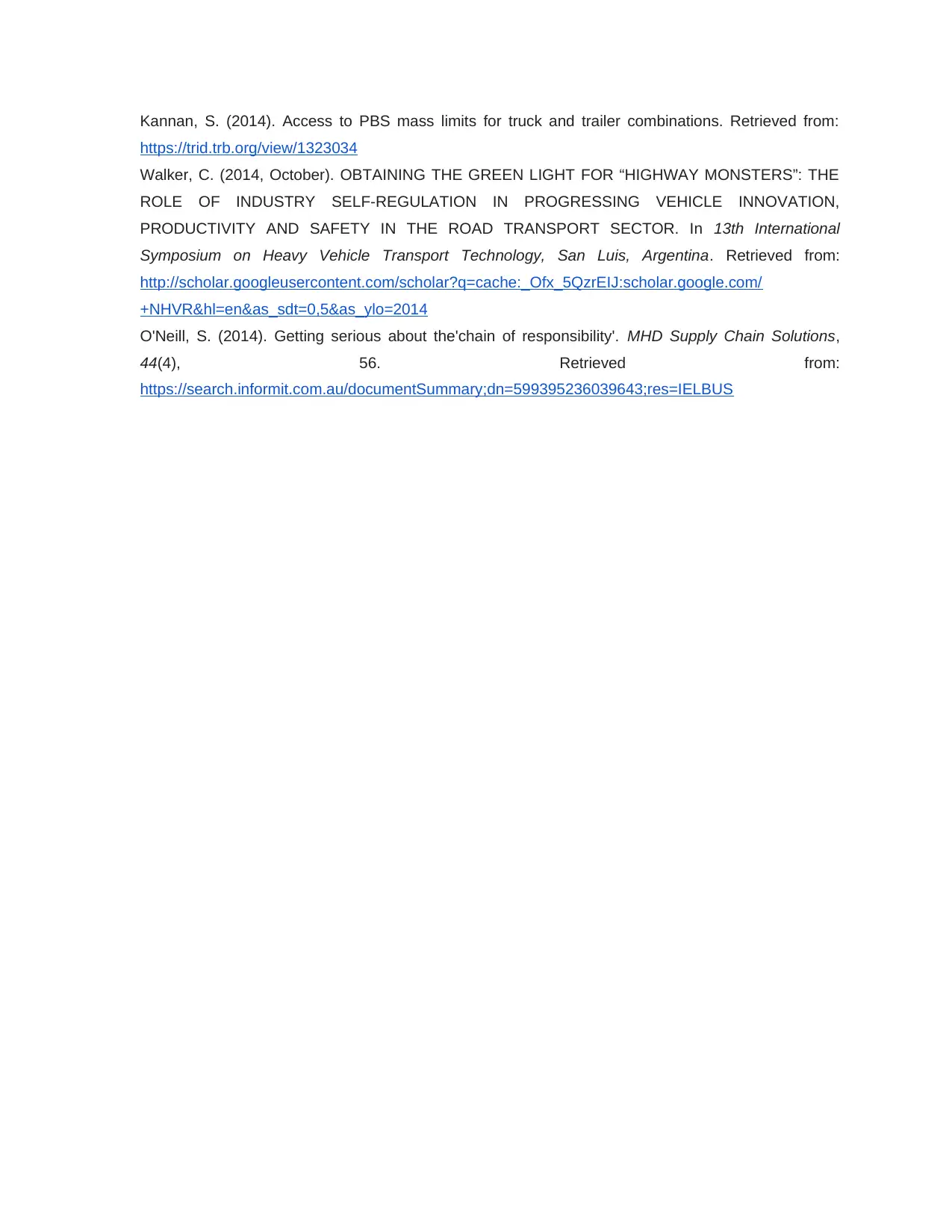
Kannan, S. (2014). Access to PBS mass limits for truck and trailer combinations. Retrieved from:
https://trid.trb.org/view/1323034
Walker, C. (2014, October). OBTAINING THE GREEN LIGHT FOR “HIGHWAY MONSTERS”: THE
ROLE OF INDUSTRY SELF-REGULATION IN PROGRESSING VEHICLE INNOVATION,
PRODUCTIVITY AND SAFETY IN THE ROAD TRANSPORT SECTOR. In 13th International
Symposium on Heavy Vehicle Transport Technology, San Luis, Argentina. Retrieved from:
http://scholar.googleusercontent.com/scholar?q=cache:_Ofx_5QzrEIJ:scholar.google.com/
+NHVR&hl=en&as_sdt=0,5&as_ylo=2014
O'Neill, S. (2014). Getting serious about the'chain of responsibility'. MHD Supply Chain Solutions,
44(4), 56. Retrieved from:
https://search.informit.com.au/documentSummary;dn=599395236039643;res=IELBUS
https://trid.trb.org/view/1323034
Walker, C. (2014, October). OBTAINING THE GREEN LIGHT FOR “HIGHWAY MONSTERS”: THE
ROLE OF INDUSTRY SELF-REGULATION IN PROGRESSING VEHICLE INNOVATION,
PRODUCTIVITY AND SAFETY IN THE ROAD TRANSPORT SECTOR. In 13th International
Symposium on Heavy Vehicle Transport Technology, San Luis, Argentina. Retrieved from:
http://scholar.googleusercontent.com/scholar?q=cache:_Ofx_5QzrEIJ:scholar.google.com/
+NHVR&hl=en&as_sdt=0,5&as_ylo=2014
O'Neill, S. (2014). Getting serious about the'chain of responsibility'. MHD Supply Chain Solutions,
44(4), 56. Retrieved from:
https://search.informit.com.au/documentSummary;dn=599395236039643;res=IELBUS
1 out of 11
Related Documents
Your All-in-One AI-Powered Toolkit for Academic Success.
+13062052269
info@desklib.com
Available 24*7 on WhatsApp / Email
![[object Object]](/_next/static/media/star-bottom.7253800d.svg)
Unlock your academic potential
Copyright © 2020–2025 A2Z Services. All Rights Reserved. Developed and managed by ZUCOL.





